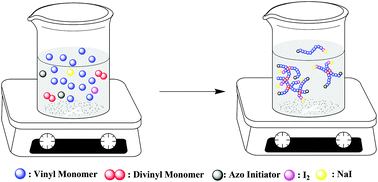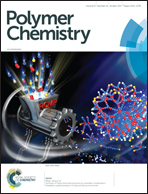Synthesis of highly branched polymers by reversible complexation-mediated copolymerization of vinyl and divinyl monomers†
Abstract
Here, we report the reversible complexation-mediated copolymerization (RCMcP) of vinyl and divinyl monomers for the synthesis of highly branched polymers. A conventional azo radical initiator, 2,2′-azobisisoheptonitrile (V65), a free-radical polymerization inhibitor (I2), and a highly reactive but inexpensive salt (NaI) were used to initiate and control the polymerization. The highly branched structures and process of branching were confirmed and thoroughly investigated. The reactivity of the vinyl groups incorporated into the copolymer was found to be similar to that of the monomers used in the RCMcP reaction. Large numbers of branched structures occurred when the conversion of MMA (conv.MMA) reached 56.6%, at which point the amount of pendant vinyl groups in the polymer reached a maximum value. The most significant branching occurred when the conv.MMA approached 90% because of intermolecular reactions between macromolecules. The polymerization reaction can also be performed without deoxygenation, with no obvious prolongation of induction. This work provides a simple, easy, and versatile method for the synthesis of highly branched polymers from commercially available compounds.



 Please wait while we load your content...
Please wait while we load your content...